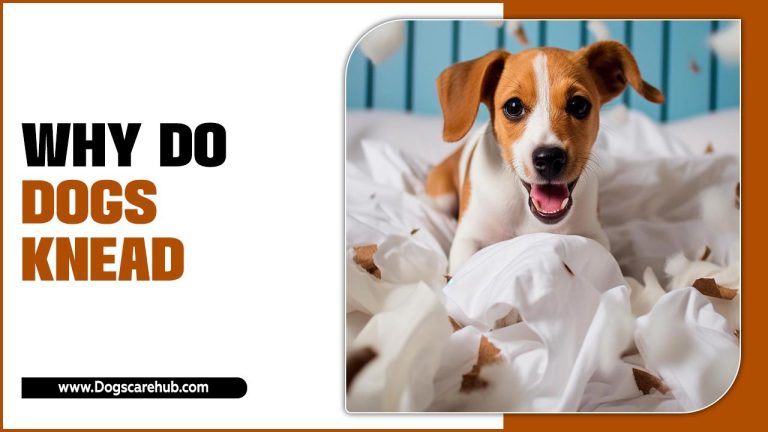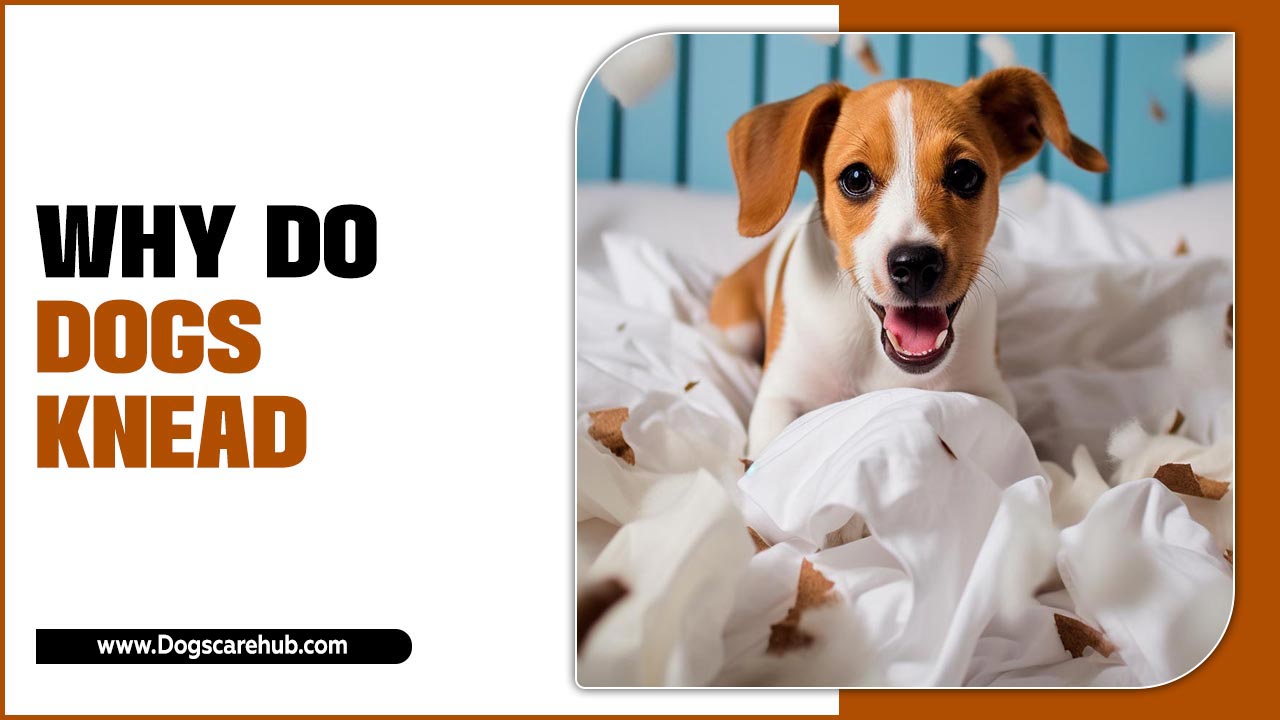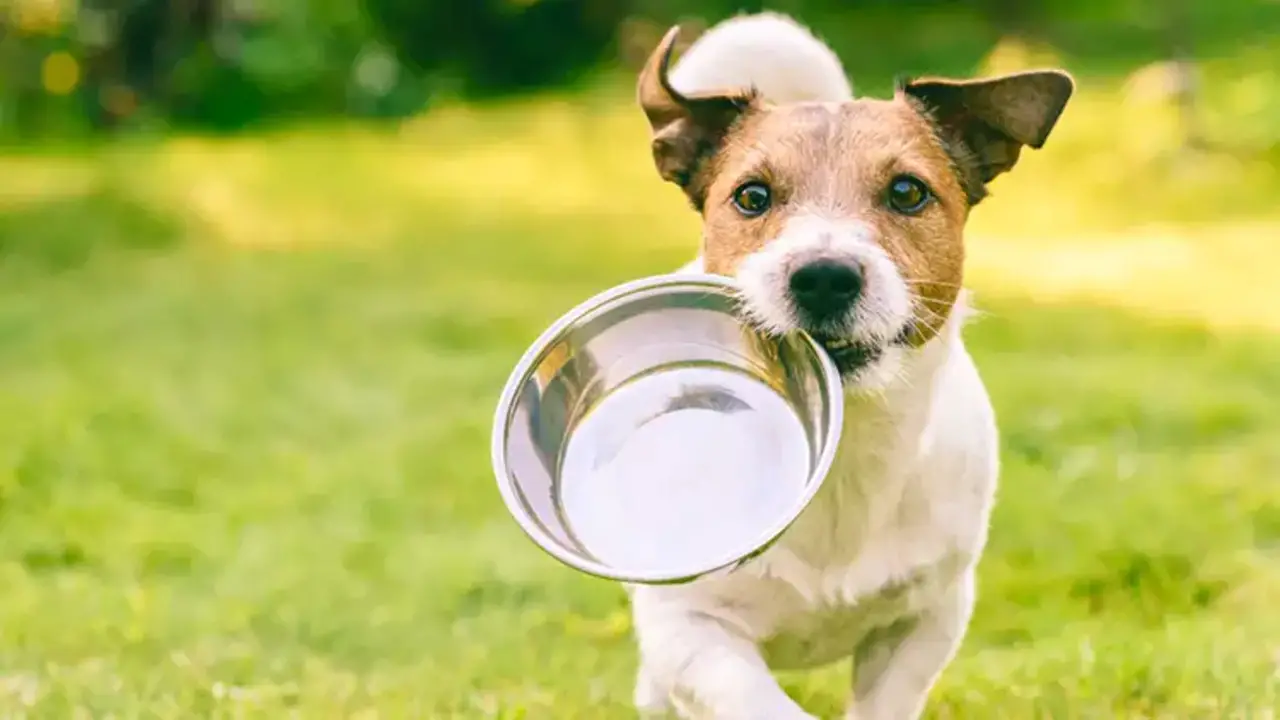
Dogs have been man’s best friend for centuries, and their unique and often quirky behaviours continue to charm and fascinate us. One such behaviour that often piques the curiosity of dog owners is when their furry friend begins to knead, a rhythmic movement that involves pushing and pulling their paws against a surface.
While it’s common for cats to knead as a sign of affection or comfort, many dog owners wonder why their four-legged companion also exhibits this behaviour. Why do dogs knead? We’ll explore the reasons why dogs knead and what it may signify.
Is it simply a leftover behaviour from their wild ancestors, or does it have a more specific purpose in their daily lives? We’ll delve into the various theories by experts in the field, including the idea that dogs knead to mark their territory or as a form of self-soothing.

Why Do Dogs Knead – All You Need To Know

why do dogs knead? Dogs knead for various reasons, and understanding their behaviour can help deepen your bond with your furry friend. One common reason dogs knead is to mark their territory. By pushing their paws into a soft surface, they leave behind their scent, alerting other animals that this area belongs to them.
Another reason dogs knead is to show affection. It’s believed that the motion is reminiscent of when they were puppies, kneading their mother’s belly to stimulate milk production. So, if your dog kneads you or a blanket, it’s likely a sign that they feel safe and comfortable in your presence.
Lastly, some dogs may knead to alleviate stress or anxiety. The rhythmic motion can be soothing and provide them with a sense of comfort. While dogs’ kneading behavior may seem peculiar at times, it’s usually an innocent and natural expression of their instincts and emotions.
What Causes Dog Kneading?

Dog kneading is a common behaviour that many dog owners have observed. There are several reasons why dogs engage in this behaviour. Various factors can cause dog kneading. From a maternal instinct that drives them to knead from puppyhood to creating a comfortable spot to rest and even as a response to anxiety or stress. Specific sights, sounds, or smells can also trigger this behaviour in dogs.
Maternal Instinct
Kneading is a natural behavior that dogs inherit from their mother. When puppies knead their mother’s teats, it stimulates milk flow, allowing them to nurse. Even as adult dogs, they might continue to knead as a self-soothing behaviour. It’s also a way for dogs to show affection and recreate the feeling of nursing.
This behaviour is not limited to female dogs or specific dog breeds; it can be observed in male and female dogs of various breeds. Dogs may knead objects such as soft toys or blankets to satisfy their maternal instinct. So, next time you see your dog kneading, remember that it’s all part of their instinctual behavior.
Temperature Control
Dogs knead blankets or bedding to create a warm and cosy den, which helps them adjust their body temperature. During hot weather, dogs may need to find a cool surface area, enabling them to regulate their body heat. Kneading can also serve as a way for dogs to find a comfortable spot to sleep.
This behaviour has its roots in their maternal instinct, as puppies knead their mother’s teats for nourishment and warmth. As dogs grow into adulthood, they may continue kneading as a self-soothing behaviour. Dogs can ensure their comfort and well-being by incorporating these temperature control techniques.
The Nursing Effect
Kneading, a behaviour often observed in dogs, is reminiscent of puppies’ nursing actions. Dogs may knead soft surfaces as objects sucking, seeking comfort and security. It can provide psychological relief for dogs, especially during stress or anxiety. Through the motion of kneading, dogs find a sense of calm and security.
This behaviour is not limited to specific dog breeds; many dogs, including dachshunds, border collies, terriers, and springer spaniels, engage in kneading. By kneading their bedding or toys, dogs mimic the comforting feeling of nursing from their mother’s teats. The nursing effect of dog kneading is a natural behavior deeply rooted in their behavioural instincts.
Anxiety

Dogs may exhibit kneading behaviour when they are dealing with separation anxiety. It can be a coping mechanism for them to alleviate their anxiousness. During stressful situations, dogs may also knead as a way to self-soothe. This repetitive motion helps them release pent-up energy caused by anxiety.
To reduce anxiety-related kneading, providing dogs with a safe and comfortable space is essential. Creating a secure environment can help alleviate their anxiety and minimize the need for excessive kneading. Understanding and addressing their anxiety can help our canine companions find healthier ways to cope with their emotions.
Bed Time Routine
As part of their bedtime routine, dogs may knead before sleeping. This behaviour can be seen as a form of preparing their sleeping area. Dogs create a cosy and secure space for themselves by kneading their bedding or blankets. The repetitive kneading helps them feel relaxed and at ease, promoting a sense of security before sleep.
Establishing a consistent bedtime routine is believed to reduce dogs’ excessive kneading behaviour. So, if you notice your furry friend engaging in this bedtime ritual, know that it is a normal and natural behaviour for dogs.
How Can You Prevent Dogs From Being Destructive?

To prevent dogs from being destructive, provide a variety of toys for mental stimulation and keep them occupied. Make sure they receive enough exercise to prevent boredom and redirect destructive behaviours through positive reinforcement training. Dogs may exhibit destructive behaviour due to boredom, anxiety, or lack of physical exercise. Additionally, create a dedicated space for them to play and relax.
Provide Alternatives
When redirecting destructive chewing in dogs, offering appropriate chew toys is essential. These toys provide an outlet for their natural instinct to gnaw and chew and help protect your belongings from their sharp teeth. Additionally, providing puzzle toys can engage dogs mentally and prevent them from getting bored and resorting to destructive behaviour.
Treat-dispensing toys are another great option, as they keep dogs entertained and distracted while rewarding them for their positive behaviour. To keep dogs engaged, offer a variety of textures and shapes in toys and rotate them regularly to maintain their interest. You can effectively redirect your dog’s destructive chewing behaviour by providing these alternatives.
Build A Dedicated Space
Building a dedicated space is essential to cater to your dog’s natural kneading instinct. Creating a designated area with appropriate surfaces will give your pup the perfect spot to indulge in this behaviour. Make sure to offer a comfortable bed or blanket for them to knead on, which will enhance their experience.
Accessibility is key, so ensure that your furry friend easily reaches the dedicated space. Adding a variety of textures, such as soft and plush surfaces, will make the space even more enticing for them. You can also make it inviting by incorporating familiar scents or toys. By building a dedicated space, you are giving your dog a place they can call their own.
Short And Trimmed Nails
Short and trimmed nails are essential for dogs that knead. Dogs engaging in this natural behaviour can be a sign of affection or comfort. Additionally, dogs have scent glands in their paws, and kneading may serve as a way to mark their territory.
Kneading also offers physical comfort by stretching and relaxing the dog’s muscles. However, long nails can cause discomfort or even injury during kneading. Therefore, keeping a dog’s nails short and trimmed is crucial. If kneading becomes excessive or problematic, it may indicate underlying issues such as anxiety, and it is advisable to seek guidance from a veterinarian or dog trainer.
Create Bonds
Kneading is a natural behaviour for dogs, allowing them to express comfort, relaxation, and affection. This rhythmic motion can also release endorphins, effectively reducing stress and anxiety levels in dogs. This behaviour is believed to stem from their puppyhood when they knead their mother’s belly to stimulate milk flow.
Through kneading, dogs strengthen their bond with their owners through physical touch and positive reinforcement. However, excessive or unwanted kneading behaviour can be controlled through proper training techniques. By understanding and addressing their needs, spending quality time together, and seeking professional guidance if necessary, owners can help create stronger bonds with their dogs.
Understanding Your Dog’s Requirements

Understanding your dog’s requirements is crucial for a harmonious relationship with your furry friend. Kneading is a natural behaviour in dogs that can signify affection or comfort. It’s their way of showing love and bonding with you. Additionally, dogs may knead to mark their territory and promote relaxation. Observing your dog’s body language and behavior can give you insight into their needs and emotions.
Providing appropriate outlets for their natural behaviours, such as digging or chewing, is essential for their overall well-being. If you notice any changes in your dog’s behaviour or health, it’s important to consult with a veterinarian. Remember, understanding your dog’s requirements strengthens the bond you share.
Consider Temperature Requirements
When understanding why dogs knead, it’s important to consider their temperature requirements. This common behaviour can have different meanings depending on the context. One reason dogs knead is to create a comfortable sleeping spot.
Pushing and pulling against a soft surface can flatten and soften their bedding, making it more suitable for their body temperature. Additionally, dogs may knead as a sign of affection or to show they are happy and relaxed. Sometimes, they simply enjoy the sensation of kneading. Pay attention to their body language, age, breed, and overall health to fully comprehend why your dog is exhibiting this behaviour.
Spend Time With Your Dog
Spend quality time with your pup to strengthen your bond and alleviate stress for you and your furry friend. Kneading is a natural dog behaviour, often associated with comfort and relaxation. It’s believed to be a leftover behaviour from when dogs need to soften the ground before sleeping.
They may also knead to mark their territory or show affection. Spending time petting and playing with your dog can help foster a strong connection. This interaction benefits both of you, promoting emotional well-being. As you spend time together, observe your dog’s body language and behaviour, understanding their needs and preferences. You can create a happy and balanced relationship by engaging in quality activities.
Hire A Professional
Hiring a professional dog trainer can provide valuable insights if you’re struggling to understand why your dog is kneading and how to respond appropriately. Professionals can help you decipher the behaviour behind dog kneading and offer effective training techniques to modify undesirable behaviours. They can guide you using positive reinforcement to maintain a positive relationship with your furry friend.
Moreover, professional trainers can develop customized training programs tailored to your dog’s unique personality and needs. The best part is that they offer long-term support, ensuring your dog exhibits desired behaviours over time. Hiring a professional can make a big difference in addressing your dog’s kneading behaviour and creating a harmonious bond.
Avoid Early Adoption
When considering bringing a new pup into your home, avoiding early adoption is important. While the behavior of dog kneading may seem harmless, it can become problematic if not properly addressed. Dogs naturally inherit this behaviour from their ancestors, who used to knead the ground or soft surfaces to create comfortable beds.
They may also knead as an affectionate gesture or to mark their territory. However, if a dog is adopted too early, it may not have received proper training and socialization. This can lead to behavioural issues such as excessive kneading or other obsessive behaviours.
Providing appropriate training and socialization throughout adulthood is essential to ensure your dog develops healthy behaviours. Avoiding early adoption and focusing on proper training can set your dog up for a happy and well-behaved life.
Conclusion
dogs knead for various reasons, including instinct, comfort, and affection. While some dog owners may find the behaviour odd, it is important to understand that kneading is common among dogs. As pet owners, we are responsible for providing our furry friends a comfortable environment where they can express themselves and thrive.
Dogs knead for various reasons, including maternal instincts, temperature control, nursing effect, anxiety, and bedtime routine. While it is a natural behaviour, it can sometimes lead to destructive habits. To prevent this, provide alternatives, build a dedicated space, keep their nails short, create bonds, understand their requirements, consider temperature needs, spend quality time with them, and seek professional help.
Why do dogs knead? Whether you allow your dog to knead depends on your preference and your dog’s behaviour. Remember always to prioritize your dog’s comfort and well-being.
Frequently Asked Questions
1.What Does A Dog Making Biscuits Mean?
Ans: When a dog “makes biscuits,” it refers to their behaviour of kneading with their paws. This instinctual behaviour is inherited from their wild ancestors, who would knead grass and foliage to create a comfortable resting spot. Dogs may knead to show affection, mark their territory, or as a self-soothing behaviour to relax.
2.Why Do Dogs Paw At Things?
Ans: Dogs often paw at things to communicate their needs or seek attention. It can also be an instinctual behaviour rooted in digging and scratching. However, pawing can indicate anxiety or stress in some dogs.
3.Is Kneading Behaviour Common Among All Dog Breeds?
Ans: Kneading behaviour is not exclusive to a specific dog breed. While some breeds may exhibit it more frequently, any dog can engage in kneading. This behaviour is often seen in puppies and younger dogs as they seek comfort and mimic nursing behaviours. Adult dogs may also need to show affection or relieve anxiety.
4.Can Kneading Behaviour Be A Sign Of An Underlying Health Issue In Dogs?
Ans: Excessive or sudden changes in kneading behaviour may indicate an underlying health issue in dogs. This instinctive behaviour is normal but could indicate pain, anxiety, skin allergies, or compulsive disorders. If you notice concerning changes, consult with a veterinarian.
5.Are There Any Ways To Train A Dog To Stop Kneading If It Becomes Problematic?
Ans: A dog can be trained to stop kneading by redirecting their behaviour with an appropriate toy or object. Consistency and positive reinforcement are crucial in curbing unwanted behaviours like excessive kneading. If the behaviour persists or becomes concerning, consult a professional trainer or veterinarian.
Meet Elyse Colburn, the devoted canine companion and storyteller behind the enchanting world of “Tales, Tails, and Adventures Unleashed.” A passionate dog enthusiast with a heart full of paw prints, Elyse Colburn shares heartwarming tales and insightful adventures, celebrating the joy, loyalty, and endless antics that make every dog a true hero. Join Elyse Colburn on this tail-wagging journey, where every post is a love letter to our four-legged friends.